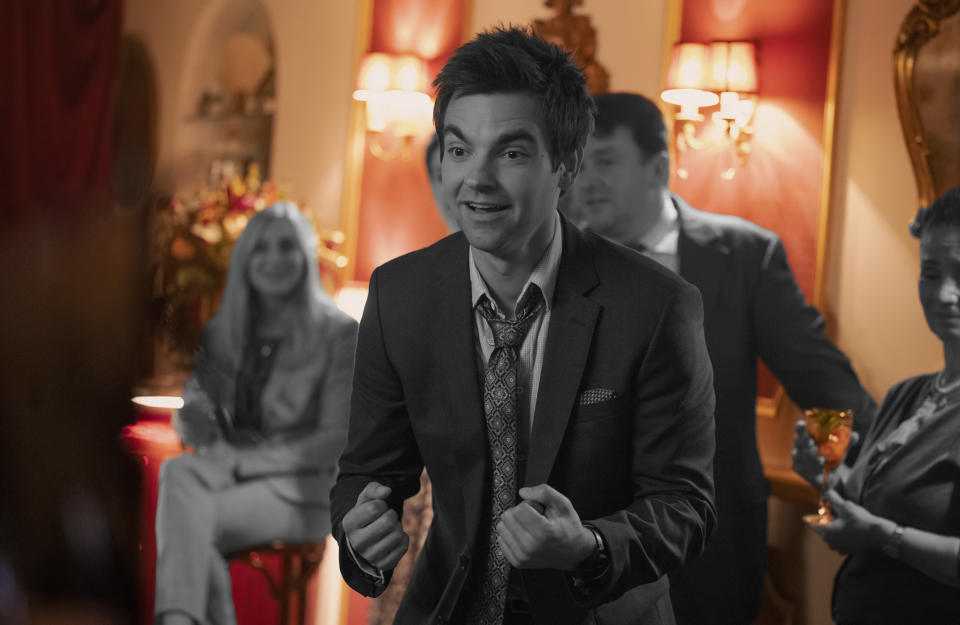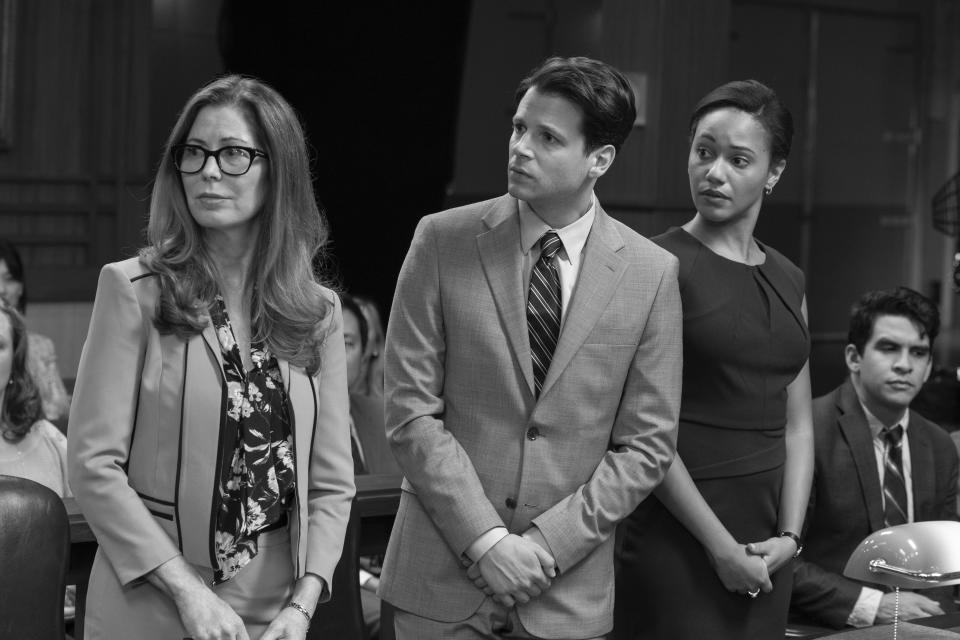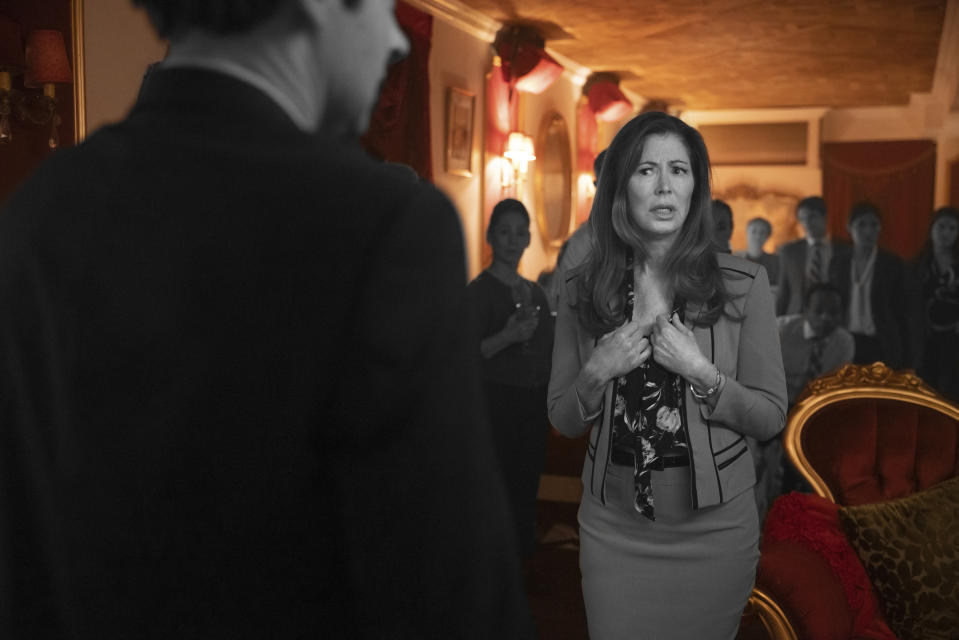How ‘The Other Two’ Achieved – and Overruled – Its ‘Pleasantville’ Homage

- Oops!Something went wrong.Please try again later.
It’s never easy for Cary on “The Other Two,” is it? The older Dubek brother (Drew Tarver) finds himself doing the yeoman’s work of television — playing a lawyer — on a long-running series called “Emily Overruled,” in Episode 4 of Season 3. But although the cast and crew of “Emily Overruled” delight in hitting their marks and going home at 5 p.m., Cary is convinced that acting should be much more and tries to inject some life into the colorless soundstage environs— a journey that required intense collaboration across multiple departments on “The Other Two.”
The show’s production design, camera, editing, and VFX teams all worked together alongside series showrunners Chris Kelly and Sarah Schneider to create a rich visual metaphor for working on a long-running series: a black-and-white world in the style of “Pleasantville,” one that throws Cary off of his game until he can bring color and life back to the set of “Emily Overruled,” and to its star (Dana Delany).
More from IndieWire
The Latest 'Barry' Is as Funny as Hopeless Desperation Can Get
'Succession' Review: Episode 9 Says Goodbye to a Father and Hello to the World He's Wrought
The process of desaturating imagery (or partial images) to make it look black and white was done through rotoscoping, or separating out and manipulating layers of imagery within each individual frame. Once the VFX team had done that, the show’s colorist, Jamie O’Bradovich, could go in and make pieces of the background pop while Cary is trapped in black and white, and slowly adjust the saturation level to exactly what each scene needed.
Some of this happens in a general way — as in the moment where the world gradually turns colorful during Cary’s climatic closing argument — but most of it was scripted by Kelly, Schneider, and Jimmy Fowlie, shot listed by Schneider, who directed the episode, and eventually handed to VFX supervisor Michael Caplan to work magic on things as diverse as a lollipop, a La Croix can, and Dana Delany’s face.
According to Caplan, his team rotoscoped over 20 “masks” for each of the 100 shots in the episode where color was manipulated in some way. And because, as anyone on “Emily Overruled” could tell you, television episodes need to be produced very quickly, Caplan only had three weeks to get all the rotoscoping done. “I think we had 50 artists on this one episode, at any given time,” Caplan told IndieWire.
“One of the cool fun things about this [episode is that normally] producing TV and film is a super collaborative process, but with visual effects, oftentimes, we’re doing the work and we’re sharing it and getting notes and feedback and back and forth; but this involved more of a collaborative handshake between all the different departments,” Caplan said. “Even from the beginning with production design, choreographing some of the colored props and the courtroom and sort of separating everything and making sure certain things were black and white and certain things were color, it involved some specific planning from the beginning.”

Caplan consulted with production designer Rocio Gimenez on the color choices and set design that could show off the saturation effects to their greatest advantage — and the process freed Gimenez to make bolder choices than the HBO Max comedy might normally go for. “I immediately went for red [for the courtroom set], something very striking,” Gimenez told IndieWire. The red is especially apparent in the sequence in Cary’s guest trailer, turned magically into an acting speakeasy with rich red sets and cocktails the black-and-white actors sip as they re-learn “zip-zap-zop.”
“The idea is that [when the color gets turned on] it hits you in the face, in a way. And we’ve been doing this for other sets as well, because the show’s a comedy and it’s very quick. So we had another set that had to be a pink room, and we went for the craziest pink, so it’s like a hit. Color was very fun [in this episode] because the reveals make everything a little more dramatic,” Gimenez said.
Gimenez also was very mindful to build in the kind of textures that wouldn’t get washed out in the black and white sections of the episode, testing with an iPhone to make sure the entire environment of the “Emily Overruled” sets, trailers, and behind-the-scenes stages all looked eerily orderly, without looking too washed out.

But sometimes the color of things onscreen was wildly different in reality. The thick gray makeup that Cary applies to Delany’s Mrs. Overruled to restore her to the world of “Emily Overruled” was “a similar color to a green screen, chroma key green makeup, so that we could then key that and pull a matte from the makeup itself,” Caplan said. “Then on the lips, we used a different color so we would be able to separate the lips from the skin, similar to a blue screen color.”
Color, texture, and tone were also important to cinematographer Charlie Gruet. “The Other Two” shot Season 3 on the Sony Venice, with a set of Cooke S4 lenses that emphasize faces and performance. For this episode, Gruet made adjustments to the show’s usual shooting style in order to create the stilted “Pleasantville” feel through the camera.
“Most of the show is handheld or has a handheld vibe. We often would use something called a Halo Head, which is a camera head that has a little bladder on it so that the camera wiggles a little bit. The operator isn’t just holding the camera for multiple takes of people just talking to each other,” Gruet told IndieWire. “But in this episode specifically, we went with more of a stable platform. We were on a dolly. We used some sliders. We used sticks to mimic the feel of ‘Pleasantville.’’”
The more controlled approach to camera movement was accentuated by editor John Daigle and his team to create an entirely different dialogue rhythm that throws Cary off. “The big challenge of this show is that it’s a lot of heightened comedy and a lot of human moments so [we need to find] a pace and a rhythm and figuring out when and how we need to sort of slow down our forward momentum. How slow is too slow? I would say with this episode in particular, one of the tougher things to figure out editorially was rhythm,” Daigle told IndieWire.

“The ‘Emily Overruled’ scenes required a more laconic energy. The people in the world of ‘Emily Overruled,’ they’re in no hurry. They don’t move quickly,” Daigle said. “So Cary has to come in like a steam engine and then get stopped in his tracks by people just staring at him in silent confusion and that sort of quiet awkwardness in a perfectly still world, that’s a very different mode of comedy for our show. So we worked really hard to make sure the timing felt right and funny and slow without making our show feel slow.”
It is extremely challenging to depict things like boredom and routine without making the audience watching feel bored. Daigle and his team A/B tested different timings to hone in on exactly the right pace, but sound also played a key role. “We used a lot of creaking chairs and awkward coughs and filling these big silences and playing with these longer moments. And I think those are reflective, a little bit, of the original ‘Pleasantville’ where [you hear a] basketball awkwardly falling after someone misses a shot. You’re trying to hit that awkward quiet in a way that doesn’t feel quiet,” Daigle said.
That trick of making something feel one way through somewhat invisible means is something that “The Other Two” has to pull off in its second-by-second editing choices, but also in its larger generic conceits and tonal choices. “What I love about this show is that, especially in this season, each episode has its own kind of distinct feel and has its own look, but yet it maintains a cohesion to the season,” Gruet said. “We definitely send up ‘Pleasantville,’ in this episode, and Episode 2 has a little bit of an indie rom-com vibe. And that is something I love as a cinematographer because it isn’t repetitive.”
“The Other Two” itself might be the ideal series for Cary to guest on: It takes big creative swings and plays with strong conceits and generic reference points — and it certainly isn’t repetitive.
Best of IndieWire
Where to Watch This Week's New Movies, from 'Fast X' to 'Master Gardener'
Every Palme d'Or Winner from the Cannes Film Festival, Ranked
Sign up for Indiewire's Newsletter. For the latest news, follow us on Facebook, Twitter, and Instagram.

